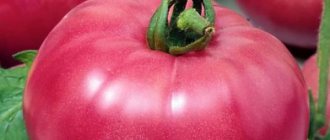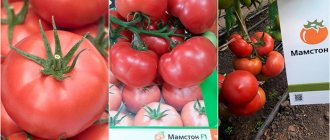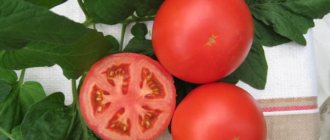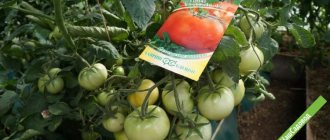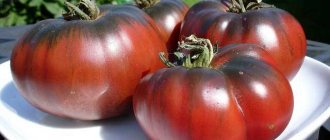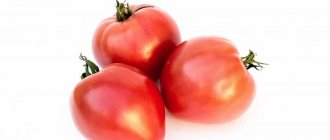| Ripening period: | average |
| Shape, weight of fruits: | heart-shaped, up to 600 g |
| Bush type: | indeterminate |
| Growing regions: | everywhere |
| Productivity: | about 6 kg per bush |
Gardeners who grow selected vegetables consider the brand to be a kind of quality mark. The Eagle's Beak tomato was no exception - with large fruits, easy to care for and very tasty. The variety was accepted by the State Register in 2005, protected by a patent, authorship belongs to V. N. Dederko, A. A. Yabrov, T. N. Postnikova.
Description and characteristics of the variety
Despite its unlimited growth potential, tomato is recommended for growing in gardens on private plots and in the fields of small farmers. It also produces a good harvest in greenhouses.
Description of the bush
The tomato variety Eagle's Beak, according to the State Register, forms an indeterminate plant. The first brush extends over the 10th plate, the next ones at intervals of 3 sheets.
The description of the variety presented by the Siberian Garden characterizes the bush as medium-sized, elongated, depending on the planting location:
- vegetable garden - 1.2 m;
- greenhouses – 1.5 m.
It would seem a contradiction. But some indeterminate varieties are prone to self-termination, when the top of a stem that has reached a certain size dries out for no apparent reason. To continue the growing season, the growth point is transferred to a strong lateral stepson.
Fruit characteristics
Multi-chambered Eagle Beak tomatoes are heart-shaped, green at the technical stage, raspberry-pink after full ripening. The photo clearly shows that the spouts, as if confirming the name of the variety, are often slightly bent. According to reviews, the first, largest fruits may be deformed and often crack.
The average weight of tomatoes is 230-360 g. The lower ones reach 600-800 g even without rationing the ovaries. As you move up, the fruits become smaller. If the summer is warm and the season is long, the last tomatoes may even fit into the jar.
The flesh of the Eagle's beak is dense, sugary, the taste is sweet, it is praised by everyone who planted the variety. There are few seeds. Keeping quality is good, the fruits ripen well during storage.
This is an excellent salad variety, which, if desired, can be used for winter preparations. The juice turns out thick, sweet, it is very good as a vitamin drink, but it is not suitable for borscht or cabbage soup.
Fruiting time and yield
The Eagle's Beak tomato ripens in the middle period. The first colored tomatoes appear 105-115 days after germination. Fruiting is extended.
Average yield of commercial tomatoes per 1 sq.m. – 10.5-14.4 kg. If we take into account that no more than 75% of the fruits go on sale, in fact 14-19.2 kg are harvested from such an area.
The remaining 25% are considered unmarketable due to cracked or deformed tomatoes, but this does not make them any less tasty.
Growing
The main method of cultivation is seedling technology. The plant is capable of bearing fruit in outdoor and greenhouse conditions, but with the latter option the yield rates are higher. The time for planting seeds is determined individually depending on the climatic conditions of the region. The period for planting work is considered to be the beginning or middle of March. Before planting, it is recommended to soak the seeds in water for 10 hours; longer duration is undesirable, as the seeds can suffocate.
Eagle's beak is a self-pollinating tomato variety; in the Russian climate, the plant is often grown in a greenhouse .
The soil for planting must be fertile. When preparing it yourself, soil, sand and peat are mixed in equal proportions. It is recommended to add a small amount of ash to the mixture, which will reduce the acidity of the soil and become a good source of nutrients for the plant. To disinfect the soil before planting, it is recommended to spill it with a weak solution of potassium permanganate. See also
Description of the aromatic tomato Kolokola Rossii and recommendations for growing the variety
Read
Picking work is carried out after the plants have formed 2 or 3 leaves. Upon reaching the age of 60 days, the plant forms a strong root system and can be planted in a place of permanent cultivation. Shoots are planted at a distance of at least 70 cm from each other; there should not be more than 3 plants per 1 m2.
Sowing dates and care features
To get a good harvest, seedlings need to be planted on time - it’s bad if they overgrow or are too small when moved into the ground. In both cases, additional time will be required for the tomatoes to adapt, which will delay the appearance of the first ripe fruits.
The eagle beak has an average maturation period. It is recommended to plant 60-65-day-old seedlings:
- into the greenhouse when the soil at a depth of 10 cm warms up to 10° C;
- to the garden - no earlier than the soil temperature reaches 15° C.
Tomatoes are sowed based on the long-term weather forecast and their own climatic conditions.
Sowing seeds
It is better not to make soil for seedlings yourself, but to buy it in a specialized store. All the fertilizers that tomatoes need are already there, and you won’t have to feed them before picking.
Although the finished substrate is usually made from peat and must undergo disinfection, it is recommended to be on the safe side. To do this, place the unopened bag in an enamel or galvanized bucket, pour boiling water over it, and cover with a lid. Leave until cool.
Eagle beak seeds are heated, pickled and soaked until they swell. The remaining operations - culling, bubbling, germination or hardening with high-quality planting material - are not necessary.
The containers are filled with a damp substrate, the seeds are planted to a depth of 1 cm. In a common container, the grains are laid out in rows every 1-2 cm. The furrows themselves are drawn at a distance of 4 cm - this will allow you to loosen the substrate and water the tomatoes at the root.
Then the containers are covered with glass or film and kept at a temperature of 23-25° C. The cover is removed daily, condensation is removed, and if necessary, the soil is moistened with a household spray bottle.
Growing seedlings
As soon as the seedlings hatch, the seedlings are placed in a cool, bright room with a temperature of:
- during the day – about 16° C;
- at night - about 6 degrees lower.
Then they are transferred to heat, and then grown at 20-25 ° C, additionally illuminated for up to 12-14 hours per day. When opening, 2-3 true leaves are dropped into a separate container.
After 2 weeks, the first feeding is given. You need to use a complete mineral complex, in which nitrogen will predominate - it is necessary for the crop to grow green mass.
Tomatoes are hardened 7-14 days before moving to a permanent place. First, leave it outside for 20 minutes, gradually increasing the time. For the last 1-2 days, the seedlings should spend the night in the open air.
Aftercare
Normally developed tomatoes are planted at the cotyledons or the first true leaf. Only the elongated seedlings are buried. Water abundantly and then leave without moisture for 10-14 days. So the root will rush deep in search of water. There is no need to pay attention to the leaves that fall during the day.
The signal for watering will be the plates that have not returned turgor overnight. In the future, tomatoes need to be moistened regularly and moderately. The Eagle's Beak variety produces large fruits; alternating periods of drought and heavy watering will lead to their cracking.
The first feeding after transplantation should be nitrogen. As soon as the second flower cluster extends, the tomato is transferred to the generative stage of development. That is, they forcibly stop the growth of green mass, directing all the plant’s forces to flowering, forming ovaries and filling fruits. To do this, reduce nitrogen in fertilizers to a minimum and provide more potassium, calcium and phosphorus.
Form the Eagle's beak into two stems. They are firmly tied to the support, and the stepsons and leaves under the fruit cluster that has begun to fill are promptly removed.
Features of planting and growing the Eagle's beak tomato
Like all tomatoes, the Eagle Beak tomato is grown from seedlings. To choose the timing of sowing seeds, you need to focus on the climate of the region and the condition that the seedlings should spend about two months at home. Therefore, for example, for open ground in the Central region and similar climatic areas, it is not worth sowing seeds in boxes before mid-March.
The process of growing seedlings has no special features, you just need to take into account that this variety may not grow very strong: the stems of the Eagle Beak tomato are not strong at any age. Therefore, there is no need to let the seedlings become fattened: water to a minimum, try to do without fertilizing, do not create a temperature above 20–22 °C (in the first week after emergence - no higher than 16 °C). It is advisable to plant seedlings at 10–12 days of age not in a common box, but in separate cups with a volume of at least 300–400 ml.
To prevent the seedlings from stretching out, they need to be given a large pot and kept in spartan conditions
Seedlings are planted in the garden bed after mandatory hardening, when warm weather arrives. The planting scheme is any convenient, but there should be no more than three plants per square meter. The Eagle's Beak tomato is demanding on nutrition, therefore, in addition to the usual dressing of the bed, an additional glass of humus and a handful of wood ash are placed in each hole.
The bushes form into one or two stems, which require tying up quite early. Stepchildren grow rapidly, so they need to be broken out weekly. The lower leaves are removed as the fruit grows, and with the beginning of ripening, those that cover the tomatoes from the sun are removed. The largest fruits should be tied up individually or supported under the stalks. It is more convenient to tie this tomato not to individual stakes, but to trellises.
This tomato is watered as usual, and fed every two weeks: first with infusions of mullein or cut herbs, and in the second half of summer - with infusions of ash. A month before the expected frost, pinch the tops of the shoots and remove those flowers from which fruits have not yet formed.
The tops of the shoots must be pinched in time so that the bush does not waste its strength
It is better to pick the fruits in a state of blanche ripeness: if they have already begun to turn brown, they will ripen perfectly in the apartment. This does not apply to completely green tomatoes. If you need to collect seeds for sowing next year, a couple of tomatoes should be left on the bush until fully ripe.
The variety's disease resistance is average, so in problem regions preventive spraying of bushes with copper-containing preparations or Fitosporin is carried out. To repel harmful insects, it is useful to sprinkle the beds with dry ash and ground pepper, and also to grow fragrant herbs and flowers nearby.
Similar varieties
According to the characteristics and description, Eagle's Beak is similar to the following large-fruited varieties:
- Pudovik tomatoes. Indeterminate mid-season, selection “Siberian Garden”. The tomatoes are shaped like a heart, crimson, with 4 or more nests. The weight of the fruit is on average 290 g, the yield is 15.5 kg per square meter.
- Raspberry ox heart. Indeterminate tomato from the Astrakhan enterprise "Agrovnedrenie". Medium ripening, with smooth raspberry skin, 4-6 chambers, heart-shaped, weighing 350-500 g. The taste is so good that it is considered the standard, the yield of marketable fruits per square meter. m – about 6 kg.
- Variety Sugar Nastasya. Late-ripening indeterminate tomato from Moscow Agro. It stands out for its pink, very tasty, heart-shaped fruits weighing 300-400 g. From 1 sq. m. On average, 10 kg of commercial tomatoes are harvested.
The Eagle's Beak variety is rightfully considered one of the best large-fruited indeterminate tomatoes intended for growing in vegetable gardens, farm fields and in protected ground. Among its advantages are easy care, excellent taste and high yield.
Pests and diseases
The tomato variety is resistant to many tomato diseases. To prevent diseases, the soil before planting is spilled with potassium permanganate and sprinkled with wood ash. Such actions will destroy pathogenic microflora and reduce the risk of plant disease.
Watering is carried out with warm water. To prevent diseases, it is recommended to spray the shoots several times with a weak solution of manganese or Fitosporin during the growing season. Adding wood ash to the soil will help prevent the appearance of parasites.

